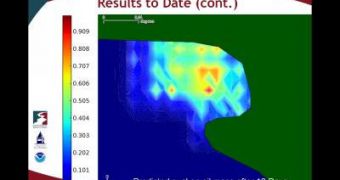A group of investigators in the United States, based at the University of Miami (UM), announce the creation of a new computer model and simulation that can account for how oil will behave during and after a major spill. The computerized tool can theoretically predict the location of oil masses that sink during such a catastrophe, and can also project their evolution on time lines. Its developers believe that rescue workers and authorities planning recovery and clean-up efforts could benefit from this application to a great extent. They add that the tool is ready to assist BP and federal authorities in their mission to clean up the Gulf of Mexico.
“Sunken oil is difficult to 'see' because sensing techniques show only a small space at a point in time. Moreover, the oil may re-suspend and sink, with changes in salinity, sediment load, and temperature, making fate and transport models difficult to deploy and adjust. For these reasons, we have developed a unique approach to the problem, bridging sampling plan techniques with pollutant transport modeling, to create models of sunken oil,” explains UM College of Engineering professor of environmental engineering James Englehardt. He is the leader of the team that developed the new computer model.
Funding for this investigation came from the Coastal Response Research Center, which is based at the University of New Hampshire. The computer tool itself was developed for the US National Oceanic and Atmospheric Administration (NOAA) Ocean Service Office of Response and Restoration, which is based in Seattle. It took about two years for the UM group to take into the account all the variables that are at play in determining how oil slicks respond to the environments in which they form.
The team says that the research initiative had three main objectives. The first was to collect as much data as possible on previous instances of oil spill, and to gather information on how the crude behaved in those cases. The next goal was to develop a two-dimensional model of various locations where oil may sink. The simulation needed to be able to accept spatial field data and hydrodynamic information. This requirement was set in place so that, in the end, the simulation could forecast how oil would behave over time. The third objective was to verify the results against actual oil spills, and against other computer models of the same type.

 14 DAY TRIAL //
14 DAY TRIAL //